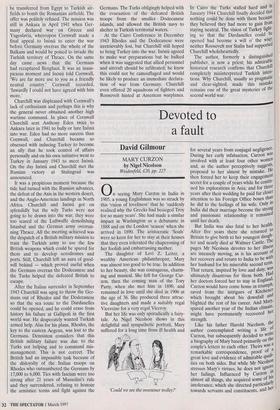Devoted to a fault
David Gilmour
MARY CURZON by Nigel Nicolson Weidenfeld, £20, pp. 227 0 n seeing Mary Curzon in India in 1905, a young Englishman was so struck by this 'vision of loveliness' that he 'suddenly realised why the Greeks had besieged Troy for so many years'. She had made a similar impact in Washington as a debutante in 1888 and on the London 'season' when she arrived in 1890: The aristocratic 'Souls' were so keen for her to stay at their houses that they even tolerated the chaperoning of her foolish and embarrassing mother.
The daughter of Levi Z. Leiter, a wealthy American philanthropist, Mary was almost too good to be true. In addition to her beauty, she was courageous, charm- ing and musical. She fell for George Cur- zon, then the coming man of the Tory Party, when she met him in 1890, and remained in love until she died in 1906 at the age of 36. She produced three attrac- tive daughters and made a suitably regal Vicereine for a very regal Viceroy.
But her life was only sporadically a fairy- tale. As Nigel Nicolson shows in this delightful and sympathetic portrait, Mary suffered for a long time from ill health and `Could we see the sweetener trolley?' for several years from conjugal negligence. During her early infatuation, Curzon was involved with at least four other women and, as the author perceptively suggests, proposed to her almost by mistake. He then forced her to keep their engagement secret for a couple of years while he contin- ued his explorations in Asia; and for three years after their wedding he paid far closer attention to his Foreign Office boxes than he did to the feelings of his wife. Only in India did their marriage become the strong and passionate relationship it remained until her death.
But India was also fatal to her health. After five years there she returned to Britain to give birth to her youngest daugh- ter and nearly died at Walmer Castle. The pages Mr Nicolson devotes to her illness are intensely moving, as is his account of her recovery and return to India to be with her husband for his miserable second term. That return, inspired by love and duty, wa,s, ultimately disastrous for them both. 1-15.413 her doctors forced her to stay in Englanu' Curzon would have come home in triumph' saved from the intrigues of Kitchener which brought about his downfall and blighted the rest of his career. And MarY' spared another year of the Indian climate, might have permanently recovered her strength. Like his father Harold Nicolson, the author contemplated writing a life of Curzon, but subsequently decided to write a biography of Mary based primarily on the couple's letters to each other. Theirs was 3 remarkable correspondence, proof of great love and evidence of admirable van' ties on both sides. But while Mr Nicolson stresses Mary's virtues, he does not ignore her failings. Influenced by Curzon In, almost all things, she acquired some of his intolerance, which she directed particularly towards servants and constituents, and her years as Vicereine were marred by occa- sional arrogance. Perhaps her most crucial failing was her inability to criticise her hus- band, a man whose great but unbalanced talents needed the guidance of a sensible wife.
While the publishers' decision to reissue this work, which deservedly won the Whitbread Biography Prize 20 years ago, is laudable, it is a pity that they should have done so without alterations. Whether or not the results of more recent research Might advantageously have been incorpo- rated, the text would certainly have benefit- ed from the correction of several dates, facts and quotations. And disagreeable though he sounds, the Curzons' tenant at Carlton House Terrace, 'a Mr Choate', may by now deserve identification as the American ambassador in London.
David Gilmour's Curzon is published by John Murray (£25) and Paper mac (L15).



























































 Previous page
Previous page